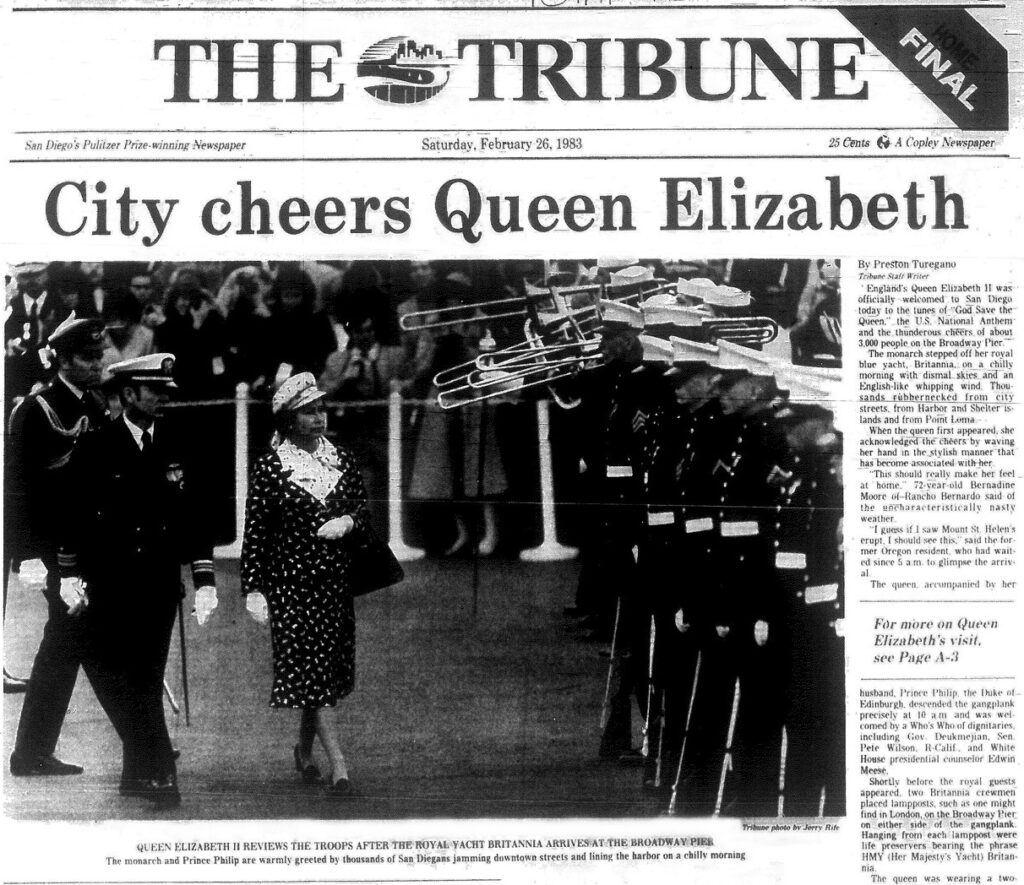
Chapter 24, Exit 15B (B Street): San Diego City Administration Building
From the left branch of Exit 15B, turn left onto B Street and follow it to where it ends at the Plaza. Go into the Plaza by foot and turn left. You will be facing the rear of City Hall, which is located at 202 C Street.
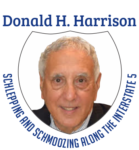
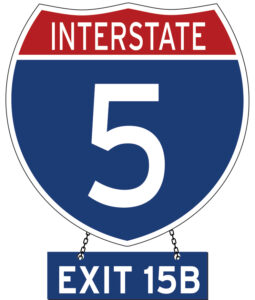 The San Diego Civic Center includes San Diego City Hall, a multipurpose Golden Hall (often used for Election Night tallying and for Naturalization ceremonies), and the Civic Center Theatre, home of the San Diego Opera and host to touring Broadway productions. Dedicated in 1965, the outdoor area between these facilities and the multi-level parking garage is named after a former mayor as the Charles C. Dail Community Concourse.
The San Diego Civic Center includes San Diego City Hall, a multipurpose Golden Hall (often used for Election Night tallying and for Naturalization ceremonies), and the Civic Center Theatre, home of the San Diego Opera and host to touring Broadway productions. Dedicated in 1965, the outdoor area between these facilities and the multi-level parking garage is named after a former mayor as the Charles C. Dail Community Concourse.
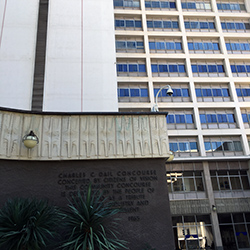
Since 1981, there have been seven Jewish members of the City Council—two of whom went on to become elected as the city’s mayor. Additionally, there have been Jewish staff members far too numerous to count. In 1983, I had the privilege of serving as communications director (press secretary) for Acting Mayor Bill Cleator. I had been covering the 1982 gubernatorial campaign that pitted Los Angeles Mayor Tom Bradley, a Democrat, against Attorney General George Deukmejian, a Republican. Even before Deukmejian won, Cleator telephoned me to invite me to serve as his communications director, explaining that the then mayor, Pete Wilson, a Republican, seemed a shoo-in to defeat Gov. Jerry Brown, a Democrat, in the election for an open U.S. Senate seat. In such case, Cleator explained, as the city councilman who presided over the council’s meeting – a position that carried the title of deputy mayor – he would be elevated to serve as acting mayor until an election could be held and certified to choose a permanent replacement for Wilson.
“But Bill,” I responded. “I’m a Democrat and you’re a Republican.”
“I don’t give a shit,” he answered immediately. “I won’t listen to you anyway.”
I laughed and accepted the job. (Some years later my wife and I both changed our registration from Democrat to independent, where we remained ever since.)
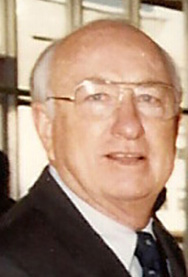
No sooner than Cleator took over the office as acting mayor, he broke the news to me that Queen Elizabeth II of England would be visiting San Diego, and that I, as communications director, would be in charge of the city’s press arrangements for the traveling and local media.
The Queen had a busy schedule in San Diego, ranging from praying at the Saint Paul’s Cathedral (Episcopal) to visiting the San Diego Museum of Art and the Old Globe Theatre. Her visit also included to touring the aircraft carrier USS Ranger. If I recall correctly, there were 18 stops in all, and each one had to be “advanced” with representatives from the U.S. State Department and Her Majesty’s government. I remember that the Queen was scheduled to climb a ladder from one deck to another on the Ranger. Her loyal team measured the distance between the rungs to make certain that it was no more than 18 inches lest the royal hemline ride up to the royal thigh. The ladder passed muster. We put together for the news media a booklet containing a background sheet about every place the Queen was scheduled to visit, just in case the media wanted to include local color in their stories.
At the San Diego Museum of Art, members of the City Council and other dignitaries were supposed to gather along with expatriates from the United Kingdom in the Sculpture Garden for a brief meet-and-greet with the Queen. Very unfortunately, it began to rain so heavily that the reception was moved inside to the lobby of the Museum of Art. Everyone knew where they were supposed to stand in the Sculpture Garden, but they had to improvise in the sudden chaos of the museum’s lobby. Cleator was able to gather the City Council together for introductions to the Queen and her consort, Prince Philip, but the other guests assembled helter-skelter, leading to some confusion.
After the City Council members were introduced to the Queen, Cleator looked to her advance team for some direction. They motioned him to move to the front door. However, behind them were an invited group of British expatriates, who were calling ‘Your majesty! Your majesty!” to get her attention. When she started to turn toward them, the advance team again signaled Cleator, this time a bit more urgently, to conduct her towards them. At that point, Cleator extended his left arm toward the front door, with his right arm going behind the Queen, in a gesture reminiscent of Sir Walter Raleigh. “This way, your majesty,” he said. A light frown crossed her face before she complied, evidently wishing that she had more time to visit with the British expatriates. “Did you see that?” one of the British press members asked another. “Did he touch the Queen?”
The next morning I arose very early to read the news coverage of the first day of the Queen’s visit. The Los Angeles Times had a brief story reporting that the British press had been mumbling about a possible faux pas on the part of the acting mayor. One is not supposed to touch the Queen! I immediately telephoned Cleator, read him the short story, and asked, “Bill, did you touch the Queen?” “I don’t think so,” he responded, “but if I did, I apologize.” “You’re certain you don’t remember?” I followed up. “Because as soon as we hang up, some reporter will be phoning me to get a comment.” “I really don’t remember doing that,” he said. “What should I do, get out of town?” “You can’t,” I laughed. “You’re the mayor.” “But perhaps you could call over to the Queen’s party and see if there is any problem.”
No sooner had we hung up, then indeed my phone rang. “Hey, Harrison,” asked a reporter. “Did Cleator maul the Queen?”
I told him that I read the story in The Times, that Cleator did not remember touching her, but that if he did, he sincerely apologizes. I must have repeated that story to 20 reporters at least.
So, the question became, “Did he, or didn’t he?” KFMB-TV, Channel 8, had filmed the reception, including Cleator’s gesture. Like the famous Zapruder film of President John F. Kennedy’s assassination, Channel 8 ran the film in slow motion, frame by frame, and sure enough, Cleator’s hand had brushed the queen’s shoulder ever so slightly. Triumphantly, the television station drew a circle around that frame of the film to prove that yes, indeed, he did it!
Meanwhile, Cleator spoke to Prince Philip, expressing his consternation over what he might have done. Prince Philip, known more formally as the Duke of Edinburgh, told him, “Don’t worry about it, Bill. It’s just the British press, trying to find something to write about. It’s not a problem.”
Cleator and I relaxed after we learned that no, he hadn’t created an international incident. More events followed that day, and soon Her Majesty was headed aboard HMS Britannia, her royal yacht, up the California coast. We breathed a sigh of relief. I did in particular because I learned that earlier I too had committed an inadvertent faux pas during a reception for the news media that had been held on the stern of the Britannia. At such receptions, aides to the Queen gather people up in a semi-circle. The Queen stands facing the semi-circle, turning to her right to see the first person in that configuration. With a nod, she gives that person permission to address her. Then she turns to the next person in the semi-circle, and so forth.
During our audience, most comments addressed to her were banal. “How do you like San Diego?” Very much, she responded. “So sorry about the rain” said another. Oh, said the queen, she is quite used to rainy weather. Eventually, it was my turn, and I shall do my best here to paraphrase the 1983 conversation.
“Your majesty,” I said, “Americans have a favorite story by Mark Twain called The Prince and the Pauper.”
“I don’t think I know that one,” she responded.
“Well,” said I, “it’s about the Prince of Wales and a commoner who look at each other through the palace gates, and they realize that they look like identical twins.”
“Oh yes,” said the queen, “I think I saw that once on the telly.”
“Well, what I wanted to ask you was when you were young, did you ever wish that you could exchange places with a commoner and see what it would be like to go out and not be recognized.”
Her face wrinkled as she exclaimed, “Oh, no, I quite enjoy being recognized. Just the other day, I was in Mexico, where there is no connection to the crown, and I enjoyed being greeted.”
With that, she turned to the next person in the semi-circle, indicating that the interview was over. Later, I was advised of my error. I had led the Queen in conversation, and that simply is not done. The queen leads others in conversation. My error; I apologized. But the gaffe went unnoticed in the furor over Cleator touching the Queen.
The story of Cleator and the Queen didn’t end once Elizabeth II left our city. In fact, it grew bigger in the retelling. One day soon after, Cleator was invited to stand in the pit in front of the City Council dais. He was greeted by City Councilman Mike Gotch, who later in his career would be elected to the state Assembly. Gotch, with a grin, said something to this effect: “Bill, while you were busy with the Royal visit, we members of the Council got together and passed a little resolution, giving you a pat on the back for your handling of the Queen.” That set of puns occasioned quite a few guffaws, and the retelling once again about Cleator’s royal mishap.
We thought the story had died down, but then we received a letter from Buckingham Palace, which we felt duty-bound to share with the media. “Mr. Cleator,” it said, “Her majesty was touched by your hospitality!” A royal pun, another news story; would Cleator’s moment of embarrassment ever be over?
Matters settled down after that until there was another ceremony at the City Council – this one involving Frank Curran, who had served as mayor prior to Pete Wilson. We had been advised that every gift given to a mayor was actually the property of the City of San Diego, and that Mayor Curran should be asked to please return any such items to the City so they might be placed in the official archives.
We telephoned Mayor Curran, and he said, “Oh great! I can clean the junk out my garage.” So, city maintenance workers hauled away the various plaques and memorabilia. Our ceremony was to thank Curran for his generosity and for his contributions to local history.
Standing with Curran in the pit, Cleator commented how pleased the city was to take possession of the historic gifts. He put his arm around Curran. Then, looking embarrassed, he quickly removed his arm, but not before the cherubic Curran commented, “Don’t worry about it, Bill, you make me feel like a king!”
***
Besides the visit of Queen Elizabeth II, another big event during the Cleator administration was the creation of the San Diego Cruise Industry Consortium – a private-public partnership created under the acting mayor’s auspices to bring together city government, the Port District, the San Diego Convention & Visitors Bureau, the hotel industry, the longshoremen, provisioners, fuel (bunkers) suppliers, tourist attractions, and other businesses that would benefit from turning San Diego into a thriving home port for cruise ships. I was put in charge of this effort, which Cleator continued to champion even after his term of office ended.
In 1984, the consortium—which I served as executive director through 1991—landed a trial season for Princess Cruises, which then was identified with the television series, The Love Boat. In fact, the Pacific Princess, which was used in the series, made its maiden call in San Diego. To celebrate we mounted the Homeport San Diego Festival, which drew 100,000 people by our count. That was the largest single-day event in San Diego until we got the city’s first of three Super Bowls in 1988. Some members of the television cast came down for the event, and the highlight was a special performance arranged by the Old Globe Theatre. Using a Zodiac boat, King Neptune, appropriately wearing a crown and carrying a trident, came up to a space close to the pier that could be viewed by a large audience. He proclaimed that henceforth the ship would be welcome in San Diego, his new cruise port!
* * *
Jewish community members have been leaders in San Diego’s civic affairs since pioneer days in the 1850s. They continue to be active today.
Louis Rose, a German Jewish immigrant, was elected to the city’s three-member Board of Trustees in 1852 and served as president of that body. This was the equivalent of serving as the mayor—from 1853 through mid-1855, when his term expired.
In those days, membership on the San Diego Board of Trustees brought with it automatic membership on the San Diego County Board of Supervisors, so in 1853 Rose became a member of the very first Board of Supervisors.
The biggest issue facing the Board of Trustees during Rose’s tenure was how to pay off the debt run up by its predecessor Common Council. That body was so profligate in its spending that the California State Legislature abolished the city’s charter. The Board of Trustees had to report to the Legislature.
Rose and his colleagues on the Board of Trustees decided to hold a public auction of lands that the city had inherited from the Mexican pueblo which had preceded statehood. Everyone was entitled to bid on lands offered for public sale, including Rose.
He purchased a spread then known as La Cañada de las Lleguas (The Canyon of the Mares), north of the city, that later became known as Rose’s Canyon, and today as Rose Canyon. The stream that runs through it is known as Rose Creek.
Rose also purchased land along the bay in what today is known as the Roseville section of Point Loma. He laid out Roseville as a residential development in 1869, hoping in vain that it could become the terminus of a transcontinental railroad stretching across the southern states.
Marcus Schiller
Marcus Schiller served on the San Diego Board of Trustees from 1860 to 1861 and returned to the Board from 1868 to 1869. The term of office in those days was one year. Schiller is remembered as one of the trustees who voted to set aside for public use the land that today is known as Balboa Park. He also was the first president of Congregation Beth Israel, a Reform congregation that is the oldest and largest congregation in San Diego. The role of Schiller and two other trustees in setting aside Balboa Park is commemorated on a plaque at the archway where the Cabrillo Bridge leads into the park’s main exhibition area.
Joseph Mannasse
Schiller’s business partner, Joseph S. Mannasse, served on the Board of Trustees in 1865, and again in 1867 through 1868. He was one of three trustees who voted to hold a public land auction at the request of the entrepreneur Alonzo Horton. That led to the establishment of Horton’s Addition to the languishing area that had been established in 1850 by William Heath Davis. Horton developed the waterfront, gave away blocks for the establishment of churches, and turned the area into San Diego’s bustling downtown. By 1872, following a disastrous fire in Old Town, most businesses relocated to downtown San Diego.
Mannasse and Schiller
Besides serving on the Board of Trustees, Mannasse and Schiller were partners in a general store that extended credit during a time when many people were land rich but cash poor. Often the partners were paid with cattle for the large variety of goods that their store imported from San Francisco. They accumulated so many head of cattle, they needed to buy ranch lands to accommodate them all. So, they purchased Rancho Las Encinitas and Rancho San Dieguito, covering all the land stretching along the coast and some miles inland from Solana Beach to Carlsbad. Among their other enterprises, they built a stagecoach stop in Carlsbad that served the San Diego to Los Angeles route. The crumbling remains of that stop may be viewed at Stagecoach Park in the City of Carlsbad.
Simon Levi
The Board of Trustees was replaced in the late 1880s by a bicameral city council that included aldermen and delegates. Among the Aldermen was Simon Levi, who would make his fortune as a wholesale grocer delivering food staples to grocers across a wide area of the southwest. He served from 1888 through 1894, and again in 1896. Levi was a pro-business and development official, having served as president of the Chamber of Commerce and the Building & Loan Association, as well as vice president of the telephone company and the gas and electric company. Earlier in his career, he was a member of the Committee of Public Safety that interceded on behalf of the immigrant Chinese community against the racist depredations of White nativists. He served as the third president of Congregation Beth Israel from 1909 to 1912.
Abraham Blochman
Abraham Blochman, the second president of Congregation Beth Israel, also served as an alderman from 1893 to 1898, as well as the consul of France, his native country. His son, Lucien Blochman, followed in his footsteps, serving on the City Council in 1897 and again in 1905. Lucien also was a charter member of the Eduard Lasker Lodge of the B’nai B’rith organization and the second Commodore of the San Diego Yacht Club, which he had helped to found in 1886. The family store, M. Blochman & Son, dealt in groceries, liquor and general merchandise, and business was good enough to enable the family to organize the Blochman Banking Company, which with new investors and mergers ultimately was transformed into the Security Pacific National Bank. Lucien also became president of the California Life Insurance Company, as well as several coal and oil production companies.
Susan Golding
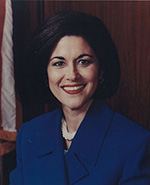
Susan Golding – whose father Brage Golding had been the president of San Diego State University – was elected in 1981 to the San Diego City Council. That was the first step in a career that would take her next to the San Diego County Board of Supervisors, and then on to become the 32nd mayor of the City of San Diego. Golding was the first member of the Jewish community to reach that position. In 1998, the middle of her second four-year term, fundraising shortfalls forced her to drop out of the Republican primary election to choose a challenger against U.S. Senator Barbara Boxer, D-California. While she had hoped to subsequently run for statewide office, those plans never came to fruition. As mayor, Golding tried to speed permitting time for businesses, championed conservation of wildlife within the city’s far-reaching boundaries, created a winter shelter for the homeless, and hosted the 1996 Republican National Convention that nominated U.S. Sen. Bob Dole, R-Kansas, to oppose Democratic President Bill Clinton’s reelection. One of Golding’s most controversial decisions was to back a ticket guarantee for the San Diego Chargers to persuade the football team to remain in San Diego. A proposed referendum election on that decision was blocked by a Superior Court judge. The Chargers played in San Diego from 1961 to 2016 before moving to Los Angeles.
Abbe Wolfsheimer
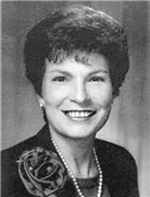
Abbe Wolfsheimer was the daughter of Col. Irving Salomon, who had been a delegate to the United Nations and who entertained the likes of President Dwight D. Eisenhower and former First Lady Eleanor Roosevelt at his Rancho Lilac in the northern San Diego County town of Valley Center. A law professor and wife of Planning Commission Chairman Louis Wolfsheimer, Abbe successfully ran for the City Council in 1985 and served in that position through 1993. An environmentalist, she was instrumental in creating the river park along the San Dieguito River and successfully pushed for State Route 56, a connector freeway between the Interstate 5 and Interstate 15, thereby reducing the miles that vehicles travel to go from one artery to another. She authored a novel of political intrigue titled The Whores of St. Joan, which some readers considered to be a jaundiced roman-a-clef about City Hall machinations. After divorcing Louis, who meanwhile had become a commissioner of the Port of San Diego, Abbe married David Stutz, a deputy district attorney who specialized in prosecuting white collar crime and who shared her love for global travel.
Bob Filner
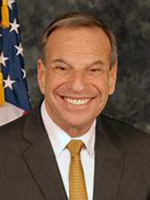
In 1987, Bob Filner, who had served as a board member of the San Diego Unified School District, was elected to the City Council, serving until 1993 when he went to Congress. During a 20-year congressional career, Filner served as chairman of the Veteran Affairs Committee, was an advocate for the rights of Filipino-American veterans, and was one of the founders of the House Progressive caucus. He was elected as San Diego’s second Jewish mayor in 2012 but served less than a year before he resigned amid many complaints by women, including staff members, of improper touching, lewd comments, and sexual harassment. His conduct was a great embarrassment, a shanda for the Jewish community.
Marti Emerald
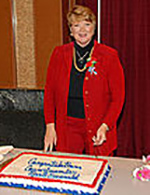
Marti Emerald, a former consumer affairs reporter for KGTV, Channel 10, was elected to the City Council in 2008 and served through 2012 in District 7 and from 2012 to 2016 in newly created District 9. She chaired the council’s Public Service and Safety Committee, pushing for greater resources for the police and fire departments. She also helped lift the cap on the number of taxis authorized to work the streets of San Diego. Emerald was credited with paving the way for a skate park in the City Heights area. Her district included a large percentage of immigrants and refugees, and Emerald was attentive to their needs, both for jobs and affordable housing.
Barbara Bry
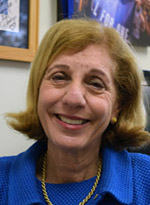
Barbara Bry, who had a master’s degree in business administration from Harvard University, came to politics following sorties into journalism and entrepreneurship. As a journalist, she covered business and the economy for the Sacramento Bee and later for the Los Angeles Times. In 1995, she helped start up a business that provided Internet connections for use in hotels and other places away from home or office. Along with Jared Polis, a future governor of Colorado, she also started ProFlowers, which delivered fresh flowers from grower to consumer, eliminating intermediate rungs on the marketing ladder.
Bry was elected to the City Council in 2016 to the same 1st District City Council seat once held by Abbe Wolfsehimer Stutz. She was a strong defender of neighborhoods, resisting efforts to densify them at the expense of the suburban lifestyle. She also was critical of the way City Hall was run, saying that there was neither transparency nor accountability in the way money was spent. In 2020, she ran unsuccessfully for the Office of Mayor, but was defeated in a runoff election by Assemblyman Todd Gloria, who earlier in his career had served as Acting Mayor following Bob Filner’s resignation from office. In 2021, she filed papers to run in the 2022 election for the combined County Offices of Assessor, Recorder, and Clerk. That position previously had been held by another member of the Jewish community, Greg Smith, from 1983 to 2008.
Jen Campbell
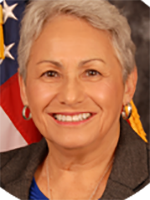
Jen Campbell, a family physician, was elected in 2018 and has been an advocate for action to curtail climate warming. She pushed for San Diego to consume 100 percent clean energy by 2035. She also favored preserving Mission Bay wetlands and reducing the use of pesticides and herbicides in city-administered parks. After she voted for a compromise on the short-term rental issue, she was the subject of an unsuccessful recall effort by those opposing any such rentals. Her colleagues on the City Council rallied to her support, electing her to serve as the council’s presiding officer from December 2020 through December 2021. Campbell and her partner Suzanne are members of the LGBTQIA community. Campbell helped shape a policy adopted in 2021 requiring all legislation and ballot proposals to be written in non-binary, gender-neutral language.
Sean Elo-Rivera
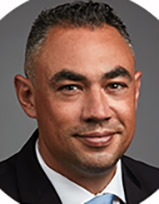
Sean Elo-Rivera was elected in 2020 to the same City Council seat once held by Marti Emerald. In December 2021, he was elected as the City Council’s president, dethroning Jen Campbell. The son of a Jewish father, whose religion he adopted, Elo became an attorney and served on the San Diego Community College’s Board of Trustees before deciding to run for the City Council. While not formally affiliated with any congregation, he attends High Holy Day services conducted by Reform Rabbi Laurie Coskey at the old Temple Beth Israel in Heritage Park.
As a City Council member, he was successful in creating a new Office of Child, Youth, and Family Success. He also has endorsed building so-called “granny flats” to increase the supply of affordable housing, to permit seniors to stay near families as they age, and to reduce homelessness. At the same time, he has called for steps to mediate any adverse impacts of increased density. As a councilmember and board member of the Metropolitan Transit System, he encourages people to use public transit, thereby lessening the need for cars and parking spaces. As chair of the City Council’s environment committee, he has favored ending free trash pickup for most single-family homes. He said free pickups create an inequitable situation in which apartment dwellers pay for their trash pick-ups and thereby subsidize the free service that is given to generally wealthier single-family homeowners.
*
Although the political parties of City Council candidates are not listed on the ballot, they almost always identify with one of the two major political parties. Of the seven Jewish community members who were elected to the City Council in the 40 years since 1981, two – Susan Golding and Abbe Wolfsheimer—were registered as Republicans (although it was said that philosophically Wolfsheimer was a strong Democrat). The five registered Democrats were Bob Filner, Marti Emerald, Barbara Bry, Jen Campbell and Sean Elo-Rivera.
*
Next Sunday, June 19, 2022: Exit 16B (6th Avenue): Ohr Shalom Synagogue
This story is copyrighted (c) 2022 by Donald H. Harrison, editor emeritus of San Diego Jewish World. It is an updated serialization of his book Schlepping and Schmoozing Along Interstate 5, Volume 1, available on Amazon. Harrison may be contacted via donald.harrison@sdjewishworld.com